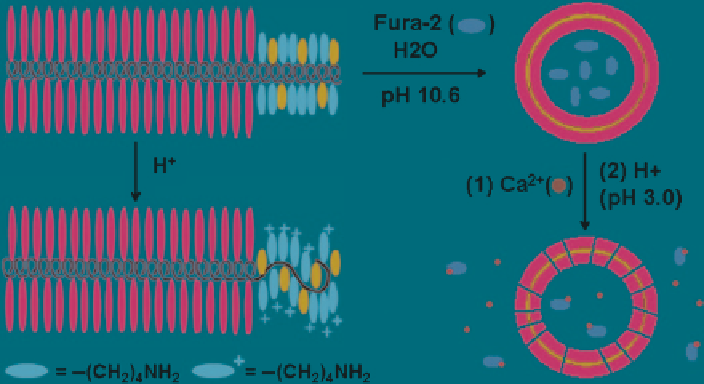Biomedical Engineering Reference
In-Depth Information
T = 25°C (PLys in a-helix); it increased further to 148 nm at the same pH = 11.7 but
at higher temperature T = 37°C (PLys in b-sheet). In all these conditions, the neutral
hydrophobic central block PBGlu retained an a-helix conformation.
While the secondary structure change in the polypeptide hydrophilic corona
induces a change in polymersome size, the mechanism has not been resolved and is
the subject of vigorous discussion (Checot et al.
2002
; Sigel et al.
2007
). The release
process seems not to be directly connected with these size changes. Conversely, the
effects of secondary structure on polymersome assemblies should be pronounced
when the stimuli-responsive polypeptide constitutes the hydrophobic layer of the
membrane. These effects are well illustrated by the following two examples.
Deming's group has introduced non-ionic block copolypeptides of L-leucine and
ethylene glycol-modified L-lysine residues, PELys-
b
-PLeu [poly(N
e
-2-(2-(2-meth-
oxyethoxy)ethoxy)acetyl -L-lysine)-
b
-poly(L-leucine)] (Bellomo et al.
2004
). These
copolypeptides have been shown to self-assemble into bilayer vesicles whose size and
structures are dictated primarily by the ordered conformations (rod-like or a-helical)
of the peptides segments. pH sensitivity can be achieved by replacing 70% of the
L-leucine in the hydrophobic domain with L-lysine. At pH = 9, the conformation of
the hydrophobic block remains a-helical and vesicles form. However, at pH = 3, pro-
tonation of the lysine residues enhances their hydrophilicity and simultaneously
destabilizes the a-helical structure of the leucine-rich domain because of electrostatic
repulsion. This helix-to-coil transition destabilises the vesicular assembly, leading to
porous membranes or complete dissociation of the structures (see Fig.
7
).
Rodriguez-Hernandez and Lecommandoux have used a zwitterionic block copo-
lypeptide, poly(L-glutamic acid)-
b
-poly(L-lysine) (PGlu
15
-
b
-PLys
15
), to form
Fig. 7
pH-responsive polymer vesicles formed from PELys-
b
-P(Leu
0.3
-
co
-Lys
0.7
)
40
. When the pH
was lowered by addition of HCl, the release of entrapped Fura-2 dye took place within seconds.
(Reproduced from ref. Bellomo et al.
2004
)

Search WWH ::

Custom Search